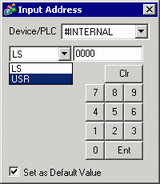Setup Process
For information on setting up communication with multiple devices/PLCs, see the following.
![]() 7.2 Connecting to Multiple Devices/PLCs
7.2 Connecting to Multiple Devices/PLCs
Device/PLC Addresses
The display unit can reference the device/PLC data. For usable addresses and device codes, refer to the "GP-Pro EX Device Connection Manual".
Select the device/PLC name (for example, "PLC1") that will communicate with the display unit, and input that address (for example, "D00000").
For example, an Input Address screen on a Word Switch.

![]()
To connect multiple devices/PLCs from the same series, in addition to connecting directly to the device/PLC you can set up virtual devices/PLCs by defining Indirect Devices. For more details, please refer to the following.
![]() 7.5 Changing the Device/PLC at Runtime (Indirect Device)
7.5 Changing the Device/PLC at Runtime (Indirect Device)
When setting up addresses in parts and scripts with display unit internal devices, you can select from the following two types of device codes. As the supported communication methods differ depending on the address area, please be careful in their use.
For example, an Input Address screen on a Word Switch.


[LS] Area
The User Area allocated in the Device/PLC connected with the Direct Access Method. You cannot use the Memory Link Method to communicate.
[USR] Area
You may use all areas as you like, up to 30,000 Words. Can be used with both the Direct Access Method and Memory Link Method.
The text data storage order is fixed to L/H, no matter what the [Text Data Mode] property is set to in the [System Settings] window's [Device/PLC] page.
[#MEMLINK] Area
The User Area for exclusive communication by Memory Link Method. You cannot use the Direct Access Method to communicate.
![]()
Data stored in the display unit's internal devices is deleted when the display unit is turned off or enters offline mode, such as when transferring. To retain internal device data, you can copy the User Area's data to backup memory (SRAM).
![]() 5.4.4.3 Display Unit [Mode] - Backup Internal Device
5.4.4.3 Display Unit [Mode] - Backup Internal Device
The Direct Access Method LS Area and the Memory Link Area (System Area) are mutually linked, with the exception of some addresses. See the following for more details.
![]() A.1.3.3 Restrictions When Using Direct Access and Memory Link Together
A.1.3.3 Restrictions When Using Direct Access and Memory Link Together